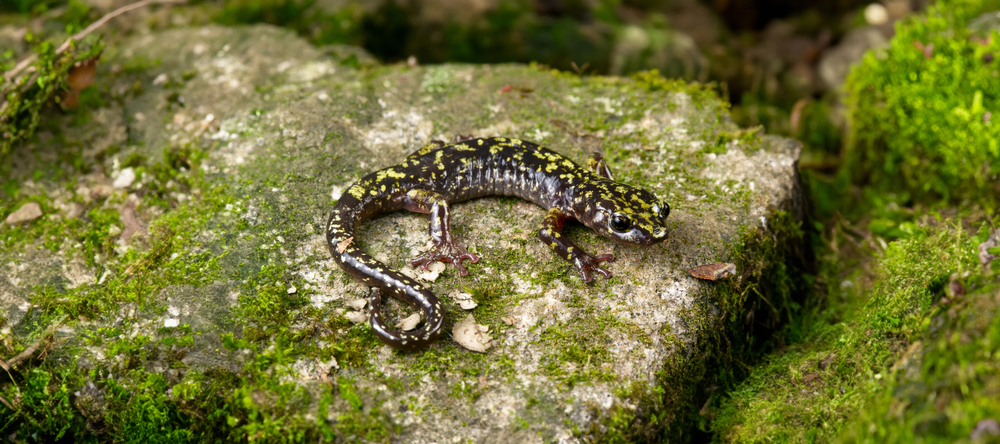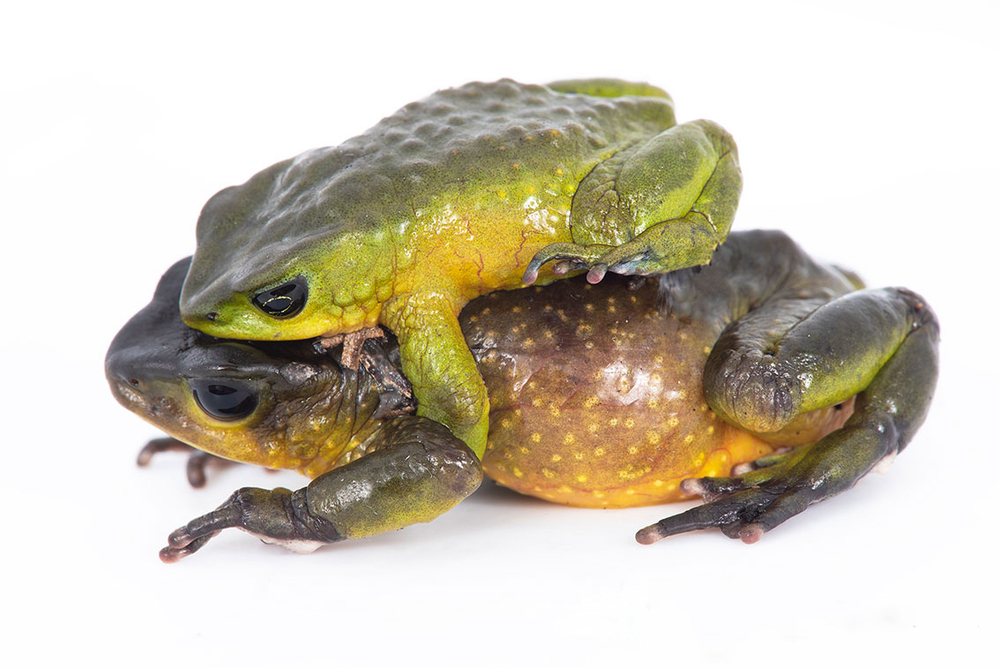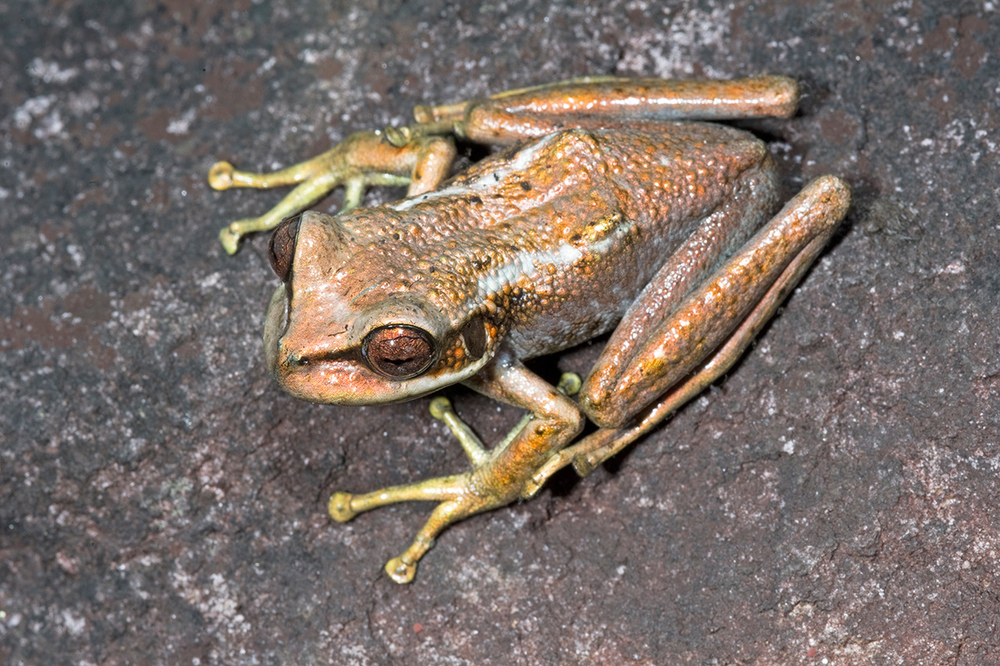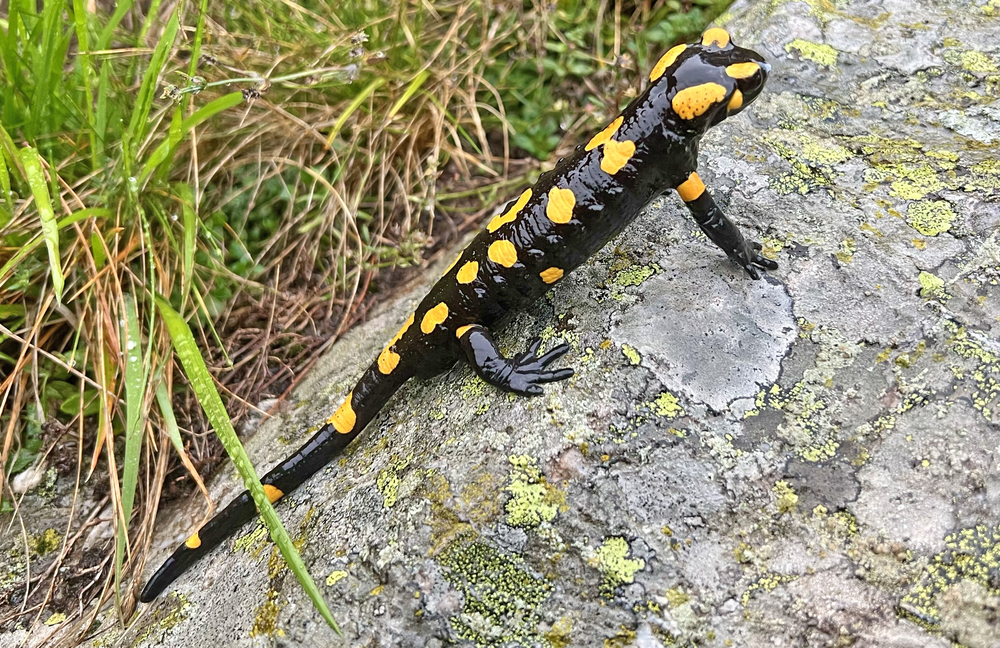
Photo: Todd W. Pierson (frame enlarged using generative AI)
According to the paper published in Nature, climate change is a major factor behind the decline of amphibians worldwide.The study conducted by more than 100 scientists has also found that salamanders are the most endangered group of amphibians, and a new emerging disease could have catastrophic consequences for salamanders in the US and Europe.
Read the article in Nature entitled Ongoing declines for the world’s amphibians in the face of emerging threats
Prof. Philippe J.R. Kok mainly assisted in investigating population trends, distribution ranges, risks, etc., and in building a scientific foundation to inform about major current threats and effective amphibian conservation actions in the Guiana Shield, more specifically in Pantepui (where tabletop mountain endemic amphibians are particularly at risk due to climate change).
Habitat destruction and disease
Habitat destruction and disease are well-documented causes of the decline of amphibians – one of the most endangered animals on the planet. The paper published today, on 4 October 2023, analysing two decades’ worth of data from around the world, has found that climate change is becoming one of the biggest threats to frogs, salamanders and caecilians.
The study "Ongoing declines for the world's amphibians in the face of emerging threats" is based on the second global amphibian assessment, coordinated by the Amphibian Red List Authority, which is a branch of the International Union for Conservation of Nature’s Species Survival Commission’s Amphibian Specialist Group, hosted and managed by Re:wild.
The report has evaluated the extinction risk of more than 8,000 amphibian species from around the world, including 2,286 species evaluated for the first time. More than 1,000 experts from around the world contributed their data and expertise. Two out of five amphibians have been shown to be at risk of extinction. Additional data will soon be published on the IUCN Red List of Threatened Species.

Photo: Prof. Philippe J. R. Kok
According to the study, between 2004 and 2022 several critical threats have pushed more than 300 amphibians closer to extinction. Climate change was the main threat to 39% of these species. This number is expected to increase as better data and projections on species’ responses to climate change become available. Climate change is of particular concern for amphibians, as they are extremely sensitive to changes in their environment.
As humans drive changes in the climate and to habitats, amphibians are becoming climate captives, unable to move very far to escape the climate change-induced increase in frequency and intensity of extreme heat, wildfires, drought and hurricanes
– said Jennifer Luedtke Swandby, Re:wild manager of species partnerships, Red List Authority coordinator of the IUCN SSC Amphibian Specialist Group, and one of the lead authors of the study. She added:
Our study shows that we cannot continue to underestimate this threat. Protecting and restoring forests is critical not only to safeguarding biodiversity, but also to tackling climate change.
According to the study, habitat destruction and degradation as the result of agriculture (including crops, livestock like cattle and livestock grazing, and silviculture), infrastructure development and other industries is still the most common threat. Habitat destruction and degradation affect 93% of all endangered amphibian species. Expanded habitat and corridor protection in the places most important for biodiversity is going to continue to be critical.
Disease caused by the chytrid fungus, which has already decimated amphibian species in Latin America, Australia and the United States, and overexploitation of the environment also continue to cause amphibian declines. Habitat destruction and degradation, diseases and overexploitation are threats that are exacerbated by the effects of climate change.
In 2022, Prof. Kok and colleagues reported the presence of the fungal pathogen Batrachochytrium dendrobatidis in Pantepui for the first time and showed that even limited human infrastructure that only allows foot-traffic is a significant risk factor for disease introduction in isolated ecosystems.
 Photo: Prof. Philippe J. R. Kok
Photo: Prof. Philippe J. R. Kok
Salamanders are particularly at risk of extinction
The study has also found that three out of every five salamander species are at risk of extinction, mainly as a result of habitat destruction and climate change, which makes salamanders the most endangered amphibian group in the world. North America is home to the most biodiverse community of salamanders in the world, including a group of lungless salamanders abundant in the Appalachian Mountains of the eastern United States. For this reason, conservationists fear that a deadly salamander disease found in Asia and Europe, called Batrachochytrium salamandrivorans (Bsal), will make its way to the Americas.
Bsal has not yet been detected in the US, but as humans and other animals can introduce the fungus to new locations, it may only be a matter of time before we see the second global amphibian disease pandemic
– said Dede Olson, a research ecologist with the USDA Forest Service, member of the IUCN SSC Amphibian Specialist Group, and co-author on the paper.
It is critical that we continue to implement proactive conservation measures to prevent the spread of Bsal into the United States, including effective biosecurity practices for wild and captive amphibians, and rapid detection and response measures. The North American Bsal Task Force includes a multi-pronged strategic plan that includes: a continental surveillance and monitoring network; scientific research identifying high-risk areas and species; and partnerships between the public, private and government sectors.
The Nature article is an update to the 2004 landmark paper that was based on the first global amphibian assessment for the IUCN Red List, which revealed the evolving amphibian crisis for the first time and established a baseline for monitoring trends and measuring conservation impact. According to the new study, nearly 41% of all amphibian species worldwide that have been assessed are now threatened to some degree – they are considered critically endangered, endangered or vulnerable. This is compared to 26.5% of mammals, 21.4% of reptiles and 12.9% of birds.
 Photo: Prof. Philippe J. R. Kok
Photo: Prof. Philippe J. R. Kok
Four amphibian species have been documented as extinct since 2004. – The Chiriquí harlequin toad (Atelopus chiriquiensis) from Costa Rica, the sharp snouted day frog (Taudactylus acutirostris) from Australia, Craugastor myllomyllon and the Jalpa false brook salamander (Pseudoeurycea exspectata), both from Guatemala. Twenty-seven additional critically endangered species are now considered likely to be extinct, bringing the total to more than 160 critically endangered amphibians that are considered likely to be extinct. The assessment has also found that 120 species have improved their Red List status since 1980. Of the 63 species whose status has improved as a direct result of conservation measures, the majority have improved due to habitat protection and management.
The history of amphibian conservation itself proves how vital this information is. If the IUCN Red List had been updated on a similar scale in the 1970s that it is today, we could have traced the sweeping amphibian disease pandemic 20 years before it devastated amphibian populations. It isn’t too late--we have this wealth of information, we have the Amphibian Conservation Action Plan, but plans and information are not enough. We need to act. We need to act fast
– said Adam Sweidan, chair and co-founder of Synchronicity Earth.
Conservationists will use the information from this study to help inform a global conservation action plan, prioritise conservation actions at the global level, seek additional resources and influence policies that can help reverse the negative trend for amphibians.
Amphibians are disappearing faster than we can study them, but the list of reasons to protect them is long, including their role in medicine, pest control, alerting us to environmental conditions and making the planet more beautiful
– said Kelsey Neam, Re:wild species priorities and metrics coordinator and one of the lead authors of the Nature paper.
And while our paper focuses on the effects of climate change on amphibians, the reverse is also critically important: that the protection and restoration of amphibians is a solution to the climate crisis because of their key role in keeping carbon-storing ecosystems healthy. As a global community it is time to invest in the future of amphibians, which is an investment in the future of our planet.
Situation of the fire salamander in Poland
As Prof. Kok told us, the fire salamander (Salamandra salamandra), which is found in southern Poland, is not currently considered endangered, mainly because it has a large distribution range. However, many populations are declining due to factors such as emerging diseases (for example, Batrachochytrium salamandrivorans, a recently described emerging fungal pathogen), residential development and habitat destruction, introduction of predatory fish (salamander larvae develop in the water and fish feed on them), agriculture and pollution with agrochemicals, etc.
 Photo: Prof. Philippe J. R. Kok
Photo: Prof. Philippe J. R. Kok
Title photo: The Hickory Nut Gorge green salamander, a species from North Carolina in the United States, is classified as critically endangered by the IUCN Red List of Threatened Species as a result of habitat destruction and degradation and the effects of climate change. (Author: Todd W. Pierson)
Source: Prof. Philippe Kok (Faculty of Biology and Environmental Protection, University of Lodz)) / Re:wild
Edit: Michał Gruda (Communications and PR Centre, University of Lodz)
The mission of the University of Lodz is to conduct reliable research and actively disseminate facts and research results so as to wisely educate future generations, be useful to society and courageously respond to the challenges of the modern world. Scientific excellence is always our best compass. Our values include: courage, curiosity, commitment, cooperation and respect.
